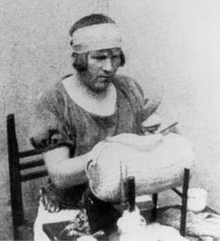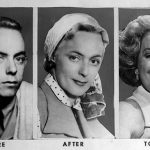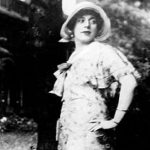
Wikipedia
Dora Richter
Born: 1891 Died: 1933
What she did: First known person to undergo complete male-to-female gender reassignment surgery
Facts:
- Richter was born to a poor farming family in 1891 and raised as male.
- Early in childhood, Richter displayed a “tendency to act and carry on in a feminine way”.
- At the age of 6 years, she apparently tried to remove her penis with a tourniquet.
- Using the name Dora, she began wearing women’s clothing and presenting as female, working under her birth name as a waiter in Berlin hotels during the busy summer season, then living as female the remainder of the year.
- She was arrested from time to time for cross-dressing, serving time in prison before being released by a judge into the care of Magnus Hirschfeld.
- Sex-research pioneer Magnus Hirschfeld at Berlin’s Institute for Sexual Research during the 1920s and early 1930s.
- With special permission from the police to wear women’s clothing, Richter worked with other transgender people as a domestic servant at the Institute for Sexual Research (one of the rare places where a transvestite could be employed), where she was affectionately known as Dörchen.
- Richter became one of five such employees at the Institute who were treated entirely as women.
- Dr. Levy-Lenz who joined the institute in 1925, recalled how the ‘girls’ would sit together “peacefully knitting and sewing and singing old folk songs. These were, in any case, the best, most hardworking and conscientious domestic workers we ever had. Never ever did a stranger visiting us notice anything…”
- In 1922, she underwent an orchiectomy (testicle removal).
- Dr. Felix Abraham, a psychiatrist working at the institute, published Richter’s gender transformation as a case study: “Her castration had the effect – albeit not very extensive – of making her body become fuller, restricting her beard growth, making visible the first signs of breast development, and giving the pelvic fat pad… a more feminine shape.”
- In early 1931, Richter had a penectomy performed by institute physician Dr. Levy-Lenz, and in June that year an artificial vagina was surgically grafted by Berlin surgeon Prof. Dr. Erwing Gohrbandt making her the first transgender woman of whom records remain to undergo vaginoplasty.
- In May 1933, with growing Nazi influence in Germany, a mob attacked the institute, and burned its records. Richter worked as a maid at the institute and is not known to have survived this attack.
- This 1975 triptych shows Christine Jorgensen when she was known as George in 1943, in 1952 immediately after her historic sex change, and in 1975 when she was nearing age 50. The center photo is the one she sent her parents in 1952, in a letter explaining the transformation. Jorgensen died in 1989. Bettmann/Corbis
- Christine Jorgensen. Google Images
Christine Jorgensen
Born: May 30, 1926 Died: May 3, 1989
What she did: First American to have gender reassignment surgery and be public about it.
Facts:
- Christine was the second child of carpenter and contractor George William Jorgensen Sr. and his wife Florence Davis Hansen.
- She later described herself as having been a “frail, blond, introverted little boy who ran from fistfights and rough-and-tumble games”.
- Jorgensen graduated from Christopher Columbus High School in 1945 and shortly afterward was drafted into the U.S. Army at the age of 19.
- After being discharged from the army, Jorgensen attended Mohawk Valley Community College in Utica, New York the Progressive School of Photography in New Haven, Connecticut and the Manhattan Medical and Dental Assistant School in New York City. She also worked briefly for Pathé News.
- Returning to New York after military service and increasingly concerned over a “lack of male physical development” Jorgensen heard about sex reassignment surgery.
- She began taking estrogen in the form of ethinylestradiol and researching the surgery with the help of Dr. Joseph Angelo, the husband of a classmate at the Manhattan Medical and Dental Assistant School.
- Jorgensen intended to go to Sweden, where the only doctors in the world who then performed the surgery were located. During a stopover in Copenhagen to visit relatives, she met Dr. Christian Hamburger, a Danish endocrinologist and specialist in rehabilitative hormonal therapy. Jorgensen stayed in Denmark and underwent hormone replacement therapy under Dr. Hamburger’s direction. She chose the name Christine in honor of Dr. Hamburger.
- She obtained special permission from the Danish Minister of Justice to undergo a series of operations in that country. On September 24, 1951, surgeons at Gentofte Hospital in Copenhagen performed an orchiectomy on Jorgensen. In a letter to friends on October 8, 1951, she referred to how the surgery affected her:
As you can see by the enclosed photos, taken just before the operation, I have changed a great deal. But it is the other changes that are so much more important. Remember the shy, miserable person who left America? Well, that person is no more and, as you can see, I’m in marvelous spirits.
- In November 1952, doctors at Copenhagen University Hospital performed a penectomy. In Jorgensen’s words, “My second operation, as the previous one, was not such a major work of surgery as it may imply.”
- She then returned to the United States and eventually obtained a vaginoplasty when the procedure became available there.
- The vaginoplasty was performed under the direction of Dr. Angelo, with Harry Benjamin as a medical adviser.
- Later, in the preface of Jorgensen’s autobiography, Harry Benjamin gave her credit for the advancement of his studies. He wrote, “Indeed Christine, without you, probably none of this would have happened; the grant, my publications, lectures, etc.”
- When she returned home in 1955, her new outgoing self, coped well with the publicity certain tabloids stirred, up with, sensationalist headlines such as: “Ex-Gi Becomes Blond Beauty” and ‘Dear Mum and Dad, Son Wrote, I Have Now Become Your Daughter.”
- The first authorized account of her story was written by Jorgensen herself in a February 1953 issue of The American Weekly, titled “The Story of My Life”.
- The publicity created a platform for her, and she used it to advocate for transgender people.
- New York radio host Barry Gray asked her if jokes such as “Christine Jorgensen went abroad, and came back a broad” bothered her. She laughed and said that they did not bother her at all. However, another encounter demonstrated that Jorgensen could be offended by some questions.
- After her vaginoplasty, Jorgensen planned to marry labor union statistician John Traub, but the engagement was called off.
- In 1959 she announced her engagement to typist Howard J. Knox in Massapequa Park, New York, where her father had built her a house in Massapequa, NY after her reassignment surgery. However, the couple was unable to obtain a marriage license because Jorgensen’s birth certificate listed her as male.
- In 1967, Jorgensen moved to California after her parents died. She left behind the ranch home built by her father in Massapequa and settled at the Chateau Marmont in Los Angeles, California for a period of time.
- It was also during this same year that Jorgensen published her autobiography Christine Jorgensen: A Personal Autobiography, which chronicled her life experiences as a trans woman and included her own personal perspectives on major events in her life.
- During the 1970s and 1980s, Jorgensen toured university campuses and other venues to speak about her experiences. She was known for her directness and polished wit.
- Jorgensen also worked as an actress and nightclub entertainer and recorded several songs. In summer stock, she played Madame Rosepettle in the play Oh Dad, Poor Dad, Mamma’s Hung You in the Closet and I’m Feelin’ So Sad.
- In her nightclub act, she sang several songs, including “I Enjoy Being a Girl”, and at the end made a quick change into a Wonder Woman costume. She later recalled that Warner Communications, owners of the Wonder Woman character’s copyright, demanded that she stop using the character; she did so and instead used a new character of her own invention, Superwoman, who was marked by the inclusion of a large letter S on her cape.
- Jorgensen continued her act, performing at Freddy’s Supper Club on the Upper East Side of Manhattan until at least 1982, when she performed twice in the Hollywood area: once at the Backlot Theatre, and later at The Frog Pond restaurant.
- This performance was recorded and has been made available as an album on iTunes.
- In 1984, Jorgensen returned to Copenhagen to perform her show and was featured in Teit Ritzau’s Danish transsexual documentary film Paradiset er ikke til salg (Paradise Is Not for Sale).
- Jorgensen was the first and only known trans woman to perform at Oscar’s Delmonico Restaurant in downtown New York, for which owners Oscar and Mario Tucci received criticism.
- Jorgensen said in 1989, the year of her death, that she had given the sexual revolution a “good swift kick in the pants”. She died of bladder and lung cancer four weeks short of her 63rd birthday. Her ashes were scattered off Dana Point, California.
- 2- Lili Elbe by Gerda Gottlieb Wikipedia
- 3- photograph of Lili herself, with Elna Tegner, wife of Danish sculptor Rudolph Tegner
- Image Via Getty Images
- 1- Lili Elbe in 1926 Wikipedia
Lili Elbe
Born: December 28, 1882 Died: September 13, 1931
What she did: Danish transgender woman and among the early recipients of sex reassignment surgery.
Facts:
- Lili Elbe was born on December 28th , 1882 in Vejle, Denmark.
- Not much is known about her childhood, but it’s speculated that Lili was intersex.
- In Lili’s case, it’s speculated she may have had Klinefelter syndrome in which a person has two X chromosomes and a Y chromosome.
- Lili lived most of her life as a man. Lili studied art at the Royal Danish Academy of Fine Arts in Copenhagen. There, she met Gerda Gottlieb. The two fell in love and Lili put a ring on it in 1905.
- One day, Gerda asked Lili to model for her dressed in women’s clothing. Lili would later write that this helped her realize her true gender identity. Lili became a regular model for her wife.
- The couple traveled around Italy and eventually ended up in France. When Lili and Gerda moved to Paris, Lili felt more comfortable dressing as a woman. She would go out in public sometimes under her male identity and other times as Lili.
- As Lili began living more openly as a woman, Gerda identified as a lesbian.
- Gerda’s paintings of Lili gained wide recognition. When the public realized the paintings were of Lili (who they understood to be Gerda’s husband) they were shocked.
- During the 1920s and 30s, Lili regularly dressed as a woman, attending events and hosting at home. Sometimes Gerda would introduce Lili as her sister as only their closest friends knew she had transitioned.
- In her autobiography, Lili wrote of a time when she dressed in a ballerina outfit, “I cannot deny, strange as it may sound, that I enjoyed myself in this disguise. I liked the feeling of soft women’s clothing. I felt very much at home in them from the first moment.”
- In 1930, Lili, who desperately wanted to have a child of her own, was ready to take the next step in her transition.
- She traveled to Germany to have sex reassignment surgery or gender reassignment surgery.
- The first surgery Lili underwent was to remove her testicles. The operation was supervised by sexologist Magnus Hirschfeld.
- For some insight as to how important these surgeries were for Lili, before she even knew surgical transition was an option, she fell into a deep depression, unable to live as the person she knew she was and unable to even name how she felt. Lili even planned her suicide but never followed through.
- The remainder of Lili’s surgeries were carried out by Kurt Warnekros, a gynaecologist and pioneer in sexual reassignment surgery. Lili’s remaining surgeries included an ovary implant, penis and scrotum removal, and a uterus transplant and vaginal canal construction. She also took synthetic sex hormones.
- After the first three surgeries, Lili legally changed her name and obtained a passport that listed her sex as female. She chose her last name, Elbe, after the river Elbe that flowed through Germany, the country of her rebirth.
- Lili’s revolutionary transition didn’t go unnoticed; newspapers in Denmark and Germany reported on the story. Unfortunately, this drew the attention of the King of Denmark, who voided her marriage to her wife Gerda. Though Gerda was a strong advocate for Lili throughout their time together, Gerda ended up going her own way, allowing Lili to live her new life on her own.
- That was not the end of Lili’s romantic life, however. She eventually became engaged to an old friend named Claude.
- Things were looking up as Lili prepared for her final surgery- the uterus transplant and vaginal construction.
- Unfortunately, after the surgery, Lili contracted an infection and her body rejected the transplant. At the time, transplant rejection drugs were still in their infancy.
- Though Lili knew she would not recover, she wrote letters to her loved ones
describing how happy she was to finally realize her dream of becoming a woman. In one letter she wrote, “That I, Lili, am vital and have a right to life I have proved by living for 14 months. It may be said that 14 months is not much, but they seemed to me like a whole and happy human life.” - 3 months after the surgery, on September 13th , 1931, Lili died of cardiac arrest induced by the infection.
- She was buried in Dresden, Germany. Her grave was then leveled in the 1960s.
LEGACY
- In 2000, author David Ebershoff wrote The Danish Girl, a novel about Lili’s life. It became a bestseller and was made into a film by the same name in 2015. The film was criticized for casting a cisgender man to play Lili.
- The production company of The Danish Girl erected a tombstone for Lili to replace the one that got mowed down.
In recent news, the World Health Organization, will no longer categorize transgender people as mentally ill!







